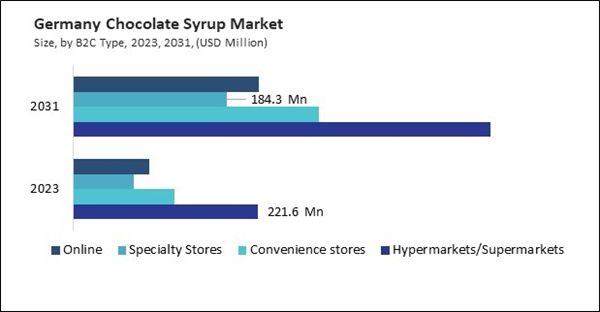Conventional chocolate syrup refers to products made from non-organic ingredients, which may include refined sugars, artificial flavors, preservatives, and other synthetic additives. This type of syrup is widely recognized for its affordability, accessibility, and classic taste. It is a staple in many households and food service establishments, often used in milkshakes, desserts, coffee beverages, and as a topping for pancakes or waffles. Thus, Europe market is expected to utilize 31.28 kilo tonnes of chocolate syrup by 2031.
The Germany market dominated the Europe Chocolate Syrup Market by Country in 2023, and is expected to continue to be a dominant market till 2031; thereby, achieving a market value of $1.74 billion by 2031. The UK market is exhibiting a CAGR of 12.6% during 2024-2031. Additionally, the France market would experience a CAGR of 14.7% during 2024-2031.
The rise in the number of online meal delivery services is another key element that is helping the expansion of the market for chocolate syrup. The convenience of ordering desserts, beverages, and specialty items for delivery has pushed restaurants and cafés to expand their dessert menus to include more creative and visually appealing offerings, many of which feature chocolate syrup.
Moreover, chocolate syrup has acquired momentum because of the increasing popularity of DIY (do-it-yourself) beverages and desserts, in addition to its conventional applications in food service and home kitchens. Chocolate syrup became a crucial ingredient in these at-home experiments, allowing consumers to easily craft indulgent treats such as milkshakes, hot chocolate, and chocolate-covered desserts.
European consumers are particularly drawn to chocolate syrup for its versatility in enhancing beverages and desserts, and the market has seen new product innovations to cater to diverse tastes. The rise of premiumization, health-conscious eating, and sustainability trends are shaping the regional demand for chocolate syrup. In the United Kingdom, the rising popularity of the café culture has been a key driver for the increasing demand for chocolate syrup. Chains like Costa Coffee and Pret a Manger and independent coffee shops frequently use chocolate syrup in popular beverages like mochas, hot chocolates, and frappes.
List of Key Companies Profiled
- Nestle S.A.
- The Hershey Company (Hershey Trust Company)
- The Kroger Co.
- The J.M Smucker Company
- R.Torre & Co. (Torani)
- Bosco Products, Inc.
- Hollander Chocolate, Inc.
- Walden Farms, LLC (PANOS Brands)
- Noushig, Inc. (Amoretti)
- Gold Pure Food Products Co., Inc.
Market Report Segmentation
By Distribution Channel (Volume, Kilo Tonnes, USD Billion, 2020-2031)- B2B
- B2C
- Hypermarkets/Supermarkets
- Convenience stores
- Specialty Stores
- Online
- Conventional
- Organic
- Germany
- UK
- France
- Russia
- Spain
- Italy
- Rest of Europe
Table of Contents
Companies Mentioned
Some of the key companies profiled in this Europe Chocolate Syrup Market include:- Nestle S.A.
- The Hershey Company (Hershey Trust Company)
- The Kroger Co.
- The J.M Smucker Company
- R. Torre & Co. (Torani)
- Bosco Products, Inc.
- Hollander Chocolate, Inc.
- Walden Farms, LLC (PANOS Brands)
- Noushig, Inc. (Amoretti)
- Gold Pure Food Products Co., Inc.









